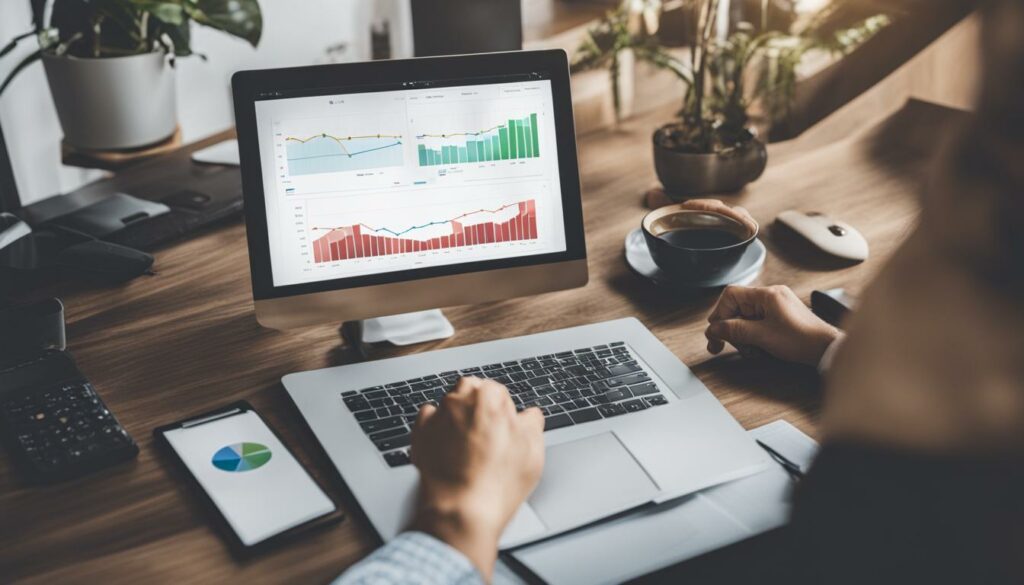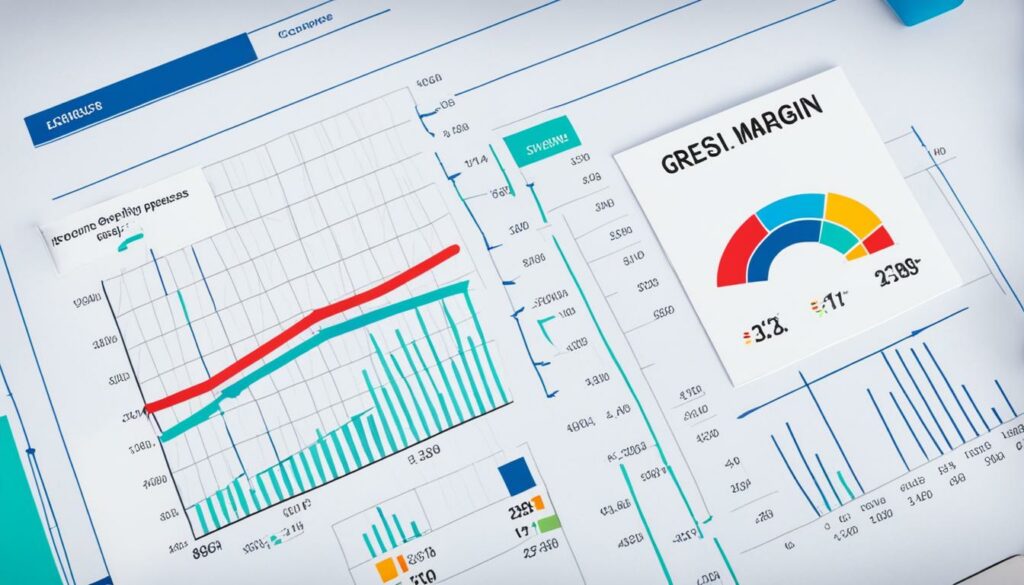Gross margin is a key metric in ecommerce businesses that measures profitability. It is the percentage of profits you retain from revenue after deducting the cost of goods sold (COGS). It is calculated using the formula Gross Margin = Revenue – COGS. Gross margin rate is the gross margin expressed as a percentage of revenue. It is calculated using the formula (Gross Margin / Revenue ) * 100. Gross margin is essential in determining if your business is making a profit on each product sold and provides room for investment and growth.
Key Takeaways:
- Gross margin is a measure of profitability in ecommerce businesses.
- It is calculated by subtracting the cost of goods sold from revenue.
- Gross margin rate is the gross margin expressed as a percentage of revenue.
- Gross margin is important in determining if your business is profitable.
- Monitoring gross margin helps identify pricing and profitability issues.
Importance of Gross Margin in Ecommerce
In ecommerce, the gross margin is a critical metric that determines the profitability and financial health of your business. It provides valuable insights into how much profit you generate from each product sold after accounting for the cost of goods sold (COGS). A higher gross margin indicates higher profitability and a stronger financial position for your ecommerce store.
Monitoring and analyzing your gross margin allows you to assess the effectiveness of your pricing strategies. It helps you determine if your pricing is appropriate and competitive within the market. By understanding your gross margin, you can make adjustments to your pricing strategy to maximize profitability.
Gross margin also plays a crucial role in making informed business decisions. By examining your gross margin, you gain a deeper understanding of the overall financial health of your ecommerce store. It provides an indication of how well your business is performing, serving as a key indicator of success.
“A higher gross margin indicates higher profitability and a healthier financial position for your business.”
Understanding and improving your gross margin leads to effective cost management, helping you identify areas where costs can be optimized to increase profitability. By analyzing your gross margin, you can identify potential cost-saving opportunities and implement strategies to drive higher profitability.

| Gross Margin Analysis | Benefits |
|---|---|
| Identifies profitability | Helps assess the effectiveness of pricing strategies |
| Improves financial health | Allows for informed business decisions |
| Aids in cost management | Identifies cost-saving opportunities |
“Gross margin provides valuable insights into how much profit you generate from each product sold after accounting for the cost of goods sold (COGS).”
By prioritizing the analysis of your gross margin, you can optimize your revenue, reduce costs, and overall enhance the financial performance of your ecommerce store. It is crucial to regularly evaluate and monitor your gross margin to ensure your business remains profitable and financially stable.
Calculating Gross Margin in Ecommerce
Gross margin is a crucial metric in ecommerce that allows you to measure the profitability of your business. To calculate gross margin, you need to subtract the cost of goods sold (COGS) from your revenue. The formula is:
Gross Margin = Revenue – Cost of Goods Sold
Revenue refers to the total sales generated by your ecommerce store, while the cost of goods sold includes all the production costs such as materials, labor, and other associated expenses.
Once you have calculated your gross profit, you can express it as a percentage of revenue to determine your gross margin. This can be done using the following formula:
Gross Margin = (Gross Profit / Revenue) * 100
By utilizing these calculations, you can gain valuable insights into the profitability of your ecommerce business. It allows you to assess whether your revenue covers the cost of production and provides room for growth and investment.
Here’s an example of a table that showcases the components and calculation of gross margin in ecommerce:
| Amount | |
|---|---|
| Revenue | $100,000 |
| Cost of Goods Sold (COGS) | $70,000 |
| Gross Profit | $30,000 |
| Gross Margin | 30% |
With these calculations, you can evaluate the effectiveness of your pricing strategies, identify areas for cost optimization, and make informed decisions to maximize profitability in your ecommerce business.

Stay tuned for the next section, where we’ll discuss strategies to improve gross margin in ecommerce.
Strategies to Improve Gross Margin in Ecommerce
To improve gross margin in ecommerce, implementing effective strategies is crucial. By optimizing pricing, production costs, and inventory management, you can maximize profitability and enhance your gross margin. Here are key strategies to consider:
1. Pricing Strategy
Analyze your pricing structure and consider increasing prices strategically. However, it is important to do so without compromising customer trust and loyalty. Research market trends and competitor pricing to ensure you are pricing your products competitively and profitably.
2. Negotiating with Suppliers
Lowering the cost of goods sold can significantly impact your gross margin. Negotiate with your suppliers to secure lower purchasing prices for raw materials or finished products. Building strong supplier relationships can provide long-term benefits when it comes to cost optimization.
3. Cost Optimization
Identify areas where you can reduce production costs to improve gross margin. Explore options to minimize shipping and warehousing expenses through efficient logistics management. Look for opportunities to streamline your supply chain and eliminate any unnecessary costs.
4. Inventory Optimization
Optimizing your inventory is crucial to reducing holding costs and minimizing wastage. Implement inventory management techniques like just-in-time (JIT) inventory or automated reorder systems to maintain optimal stock levels. This will help avoid overstocking or stockouts, which can impact gross margin.
5. Product Bundling and Cross-Selling
Increase your average order value by implementing product bundling or cross-selling techniques. Bundle complementary products together to encourage customers to purchase more items, thereby increasing the overall revenue per order. Cross-selling related products can also boost average order value.
6. Implementing Minimum Order Quantities
Setting minimum order quantities can have a significant impact on gross margin. By encouraging customers to order larger quantities, you can improve economies of scale and reduce production costs per unit. This strategy also helps optimize shipping and handling costs.
7. Customer Retention and Repeat Purchases
Focus on building customer loyalty and repeat business to increase gross margin. Provide exceptional customer service, personalized marketing campaigns, and reward programs to encourage customers to return. Repeat customers are more likely to make larger purchases and be willing to pay a premium.
Implementing these strategies can significantly improve your gross margin in ecommerce. By strategically pricing your products, optimizing production costs, and effectively managing inventory, you can enhance profitability and achieve sustainable business growth.
Remember, it’s essential to regularly review and analyze your gross margin to identify areas for improvement and make informed business decisions that align with your financial goals.
Customer Behavior and Gross Margin in Ecommerce
When it comes to gross margin in ecommerce, understanding customer behavior is crucial. Customer behavior directly impacts pricing, perceived value, and ultimately, the willingness to pay. By leveraging customer behavior insights, businesses can optimize their pricing strategies, enhance the perceived value of their products, and increase their gross margin.
One key aspect of customer behavior that influences gross margin is pricing. Pricing directly affects customers’ perception of value and their decision to make a purchase. By implementing effective pricing strategies, such as dynamic or personalized pricing, ecommerce businesses can capture the maximum value from their customers.
To justify higher prices and increase gross margin, it’s essential to focus on improving the perceived value of products. Factors such as product quality, packaging, and marketing messages play a vital role in shaping customers’ perception of value. By effectively communicating the unique selling points and advantages of their products, businesses can command higher prices and improve their gross margin.
Repeat customers are another important factor in gross margin optimization. Repeat customers are more likely to make larger purchases and are generally willing to pay higher prices for products they trust and value. By building strong customer relationships, providing exceptional customer experiences, and fostering customer loyalty, ecommerce businesses can encourage repeat purchases and drive up their gross margin.
Factors Influencing Customer Behavior and Gross Margin in Ecommerce
| Customer Behavior Factors | Impact on Gross Margin |
|---|---|
| Pricing | Directly affects willingness to pay and gross margin. |
| Perceived Value | Affects customer willingness to pay higher prices and increases gross margin. |
| Repeat Customers | Contribute to higher sales volume and higher prices, resulting in increased gross margin. |
By understanding and analyzing customer behavior, ecommerce businesses can tailor their pricing and marketing strategies to drive up their gross margin. It’s important to continuously monitor and assess customer behavior trends and adapt strategies accordingly to stay ahead of the competition and maximize profitability.

Overall, customer behavior and gross margin in ecommerce are intricately linked. By leveraging customer insights, optimizing pricing strategies, and delivering value to customers, businesses can boost their gross margin and achieve sustainable growth and profitability.
Relation of Gross Margin to Other Metrics in Ecommerce
In ecommerce, gross margin is closely intertwined with other crucial metrics that contribute to the overall financial health and profitability of a business. While gross margin primarily focuses on the cost of goods sold (COGS), metrics like net profit margin, operating income, and overall profitability provide a comprehensive understanding of the business’s financial performance.
Gross Margin vs. Net Profit Margin
Net profit margin is a metric that considers not only the COGS but also the operating expenses, taxes, and other costs involved in running an ecommerce store. It measures the overall profitability and efficiency of the business. Gross margin, on the other hand, solely focuses on the COGS and indicates the profitability generated through the sale of products.
Net profit margin takes into account all revenue and expenses, providing a comprehensive view of the business’s financial performance beyond the production costs. Although both gross margin and net profit margin are essential metrics for assessing profitability, they address different aspects of the ecommerce business’s financial health.
Operating Income and Profitability
Operating income reflects the revenue generated after deducting operating expenses, excluding taxes and interest. It provides insights into the business’s core operations and measures the profitability before considering external financial factors. Gross margin contributes to operating income by highlighting the profitability generated from the sale of goods. A healthy gross margin indicates that the business is generating profits from its products, leading to a positive impact on the operating income.
Profitability, in the context of gross margin, refers to the ability of the business to generate profits from the sale of products. Gross margin serves as a key indicator of the business’s profitability potential and allows for adjustments in pricing, expenses, and investments to maximize profitability in ecommerce.
Monitoring Financial Health
Monitoring gross margin is essential for evaluating the financial health of an ecommerce store. It provides insights into the profitability per product and overall business model. By analyzing gross margin trends over time, businesses can identify the effectiveness of their pricing strategies, production costs, and cost management practices.
A healthy gross margin not only indicates that the business is generating profits but also suggests that the current pricing strategy is achieving the desired results. It allows businesses to make informed decisions regarding pricing adjustments, expense allocation, and investment strategies. By maintaining a healthy gross margin, ecommerce businesses can ensure their financial stability and sustainability.
“Gross margin serves as a vital metric in ecommerce, providing insights into the overall profitability, financial health, and effectiveness of the business’s pricing and cost management strategies.”

In the context of gross margin, considering and understanding its relation to other metrics is crucial for a comprehensive assessment of an ecommerce business’s financial performance. By continuously monitoring gross margin and its relation to net profit margin, operating income, and profitability, businesses can make data-driven decisions to optimize financial health and maximize profitability.
Challenges and Considerations in Gross Margin Calculation
Calculating gross margin in ecommerce comes with its fair share of challenges and considerations. It is crucial to be aware of these factors to ensure accurate and reliable calculations. Let’s explore some of the key challenges and considerations:
Pricing Fluctuations
Pricing fluctuations can significantly impact gross margin in ecommerce. Industries with volatile material costs are particularly susceptible to these fluctuations. As the prices of materials fluctuate, the cost of goods sold may increase, reducing the overall gross margin. Regularly monitoring market trends and adjusting pricing strategies accordingly can help mitigate the impact of pricing fluctuations.
Material Costs
Material costs play a critical role in determining gross margin. Fluctuations in the prices of raw materials can directly impact the cost of goods sold and, subsequently, the overall gross margin. It is essential to closely monitor and analyze these costs while considering their impact on profitability. By staying informed about market trends and building strong relationships with suppliers, you can better manage and mitigate the effects of material cost fluctuations.
Production Costs
Production costs, including labor, equipment, and overhead expenses, can significantly affect gross margin. When production costs increase, the cost of goods sold rises as well, potentially lowering the gross margin. It is vital to regularly review and optimize production processes, streamline operations, and control costs to maintain profitability and maximize gross margin.
Operating Expenses
Operating expenses, such as marketing, rent, utilities, and salaries, can impact gross margin calculations. When operating expenses increase, a larger portion of the revenue is allocated to cover these costs, potentially reducing the gross margin. Monitoring and managing operating expenses are essential to ensure that they are in line with revenue and do not excessively impact profitability.
Accurate Cost Allocation
Accurately tracking and allocating costs related to the production and sale of goods is crucial for an accurate calculation of gross margin. Properly assigning costs to specific products or services helps provide a clear picture of their profitability. Implementing robust cost accounting systems and processes can help ensure accurate cost allocation and enhance the reliability of gross margin calculations.
“Maintaining accurate and reliable gross margin calculations is vital for understanding the financial health and profitability of an ecommerce business.”
By addressing these challenges and considerations, ecommerce businesses can strengthen their understanding of gross margin and make informed decisions to optimize profitability. Now that we’ve discussed the challenges, let’s explore strategies to improve gross margin in the next section.
Conclusion
Gross margin is an essential metric in ecommerce that accurately measures profitability and financial health. By effectively calculating and closely monitoring gross margin, you gain valuable insights into the overall profitability of your business model. This empowers you to make informed pricing decisions, identify opportunities for cost management, and drive the growth and success of your ecommerce store.
To improve gross margin and increase profitability, it is crucial to implement strategic pricing strategies and optimize costs. This may involve carefully adjusting prices to maintain customer trust and loyalty, negotiating better purchasing prices with suppliers, and optimizing shipping and warehousing expenses. By increasing the average order value through product bundling or implementing minimum order quantities, you can also maximize gross margin and enhance your financial performance.
Understanding the relationship between gross margin and other metrics is key to maintaining a healthy financial position. While gross margin focuses on the cost of goods sold, net profit margin considers operating expenses, taxes, and additional costs to determine overall profitability. By prioritizing gross margin and its connection to other metrics, you can strengthen your financial acumen and steer your ecommerce store towards sustained profitability and growth.
FAQ
What is Gross Margin in Ecommerce?
Gross margin is a key metric in ecommerce businesses that measures profitability. It is the percentage of profits you retain from revenue after deducting the cost of goods sold (COGS). It is calculated using the formula Gross Margin = Revenue – COGS.
Why is Gross Margin important in Ecommerce?
Gross margin is important in ecommerce as it indicates the profitability of your business. It shows how much profit is generated from each product sold after deducting the cost of goods sold. A higher gross margin means higher profitability and a healthier financial position for your business.
How is Gross Margin calculated in Ecommerce?
Gross margin in ecommerce is calculated by subtracting the cost of goods sold from revenue. The formula is Gross Margin = Revenue – Cost of Goods Sold.
What are some strategies to improve Gross Margin in Ecommerce?
There are several strategies to improve gross margin in ecommerce. One strategy is to increase prices, but this must be done carefully to maintain customer trust and loyalty. Lowering the cost of goods sold is another approach, which can be achieved through negotiating lower purchasing prices with suppliers or reducing shipping and warehousing costs. Increasing average order value by implementing product bundling or setting minimum order quantities can also help improve gross margin.
How does customer behavior affect Gross Margin in Ecommerce?
Customer behavior plays a role in gross margin in ecommerce. Pricing strategies and the perceived value of products influence customer willingness to pay. By improving the perceived value of your products through factors such as product quality, packaging, and marketing, you can justify higher prices and increase gross margin. Repeat customers also contribute to gross margin as they are more likely to make larger purchases and be willing to pay higher prices.
What is the relation of Gross Margin to other metrics in Ecommerce?
Gross margin is closely related to other metrics in ecommerce. Net profit margin takes into account operating expenses, taxes, and other costs to determine the overall profitability of your business, while gross margin focuses solely on the cost of goods sold. Gross margin provides insight into the potential profitability of your business model, indicating whether your current pricing is generating profit. It is an essential metric to monitor the financial health of your ecommerce store and make informed decisions regarding pricing, expenses, and investment.
What are some challenges and considerations in Gross Margin calculation for Ecommerce?
There are challenges and considerations to be aware of when calculating gross margin in ecommerce. Pricing fluctuations, especially in industries with volatile material costs, can affect gross margin. Increases in production costs or operating expenses can also impact gross margin. It is important to regularly review and adjust pricing and expenses to maintain profitability and maximize gross margin. Additionally, accurately tracking and allocating costs related to the production and sale of goods is crucial for an accurate calculation of gross margin.
How does Gross Margin contribute to the profitability of an Ecommerce business?
Gross margin is a vital metric in ecommerce that measures profitability and financial health. By accurately calculating and monitoring gross margin, you can assess the profitability of your business model, make informed pricing decisions, and identify areas for cost management. Implementing strategies to improve gross margin, such as pricing adjustments and cost optimization, can lead to increased profitability and overall business success. By prioritizing gross margin and understanding its relation to other metrics, you can strengthen your financial acumen and drive the growth and profitability of your ecommerce store.
